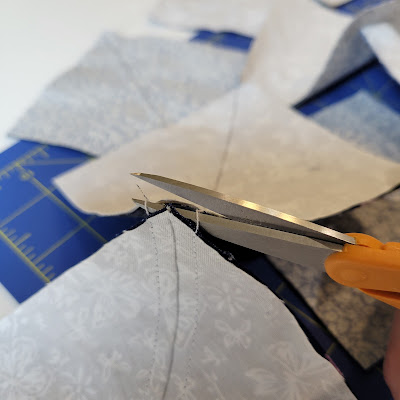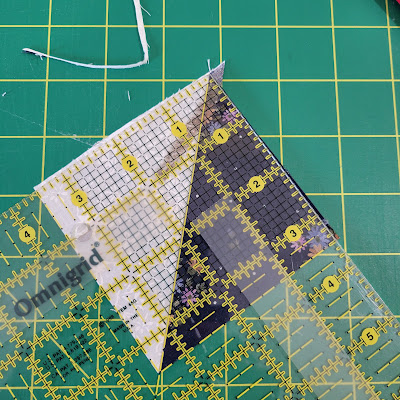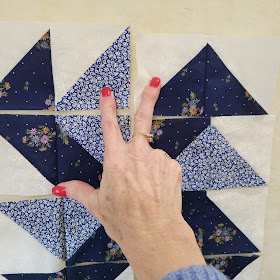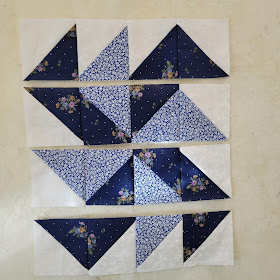I decided to take a break from HSTs and just deal with squares. I've had this fabric out for a while waiting for the perfect pattern come along and finally it did. It just looks like a flower garden and the darker blue squares allow anyone to walk through and get a closer look. Thus the title "A Stroll Through the Flower Garden". I think I've seen the pattern called while I have been "Scrolling Through the Internet".
The twelve inch block is made with a total of twenty-one blocks and two different prints. The four blocks that form the corners I call "fourzies". The other five blocks don't have a special name, but they are very special to the block. Using different prints to make the block, could totally change the story that the block tells.
While I enjoy making easy blocks, I also like to make them precise. My friends consider me a perfectionist and I guess I agree with them. I fall back on the saying, "If it's not worth doing well, it's not worth doing". I'm sharing this with you to explain some of the extremes (?) I go to.
If you have follow me or have just read a tutorial or two especially if HSTs are involved, you know I cut the square a full inch bigger than the finished size so I can square up the block and trim off the excess. This also means I have the seam in a corner right where I want it to be to meet up nicely (I didn't say perfectly, but almost did) in the block. It seems no matter how hard I try, it's never perfect, but quilters will tell you quickly that keeps you humble and proves only Jesus is perfect. Sometimes I end up having a lot of "humility squares/blocks" in my work.
Another extreme I go to is cutting strips just a little bit bigger than they are supposed to be cut if I am working on fourzies. Then I can trim them down so my fourzie will be square. I will tell you the actual width to cut the strips, but if you look closely at the picture, you will see I cut the strip 1/8th" wider.
But I need to get on with the tutorial for A Stroll Through the Flower Garden Block Square.
HOW TO MAKE AN IRISH CHAIN BLOCK (A Stroll Through the Flower Garden)
Choose three prints - a light background print,
a dark print,
and a bright focal print with flowers
CUT one(1) 4.5" square from Print #1
four (4) 4.5" squares from Print #2
one(1) 2.5" x 20.5" strip from Print #1 AND Background *
*If you are using scraps and don't have a strip that long, CUT eight (8) 2.5" squares from the Print #1 AND Background.
The first thing is to sew the two strips together right sides facing to make the fourzies using a 1/4" seam.
This picture shows how I cut the strip 1/8" wider than 2.5". Ignore the arrow - that was from a different project.
Trimming one end of the two-pieced strip, I cut a clean end and then cut the strip into 2.5" sections.
I placed the pieces on my design wall for the following pattern (If you have a keen eye, you might catch my first mistake, but I'm good, I will fix it before the important sewing takes place.)
I will make the fourzies first by sewing two of the blue/yellow strips together making sure I "nest" the seams together flatly.
PRESS the seams either way. They never meet up with another seam in the block so it doesn't matter.
PRESS first on the wrong side and
then on the right side.
Do this until you have all of the fourzies made. I made the first one completely but then decided to make the other three by "chain piecing" to show you a different technique that might save you some time and thread.
First secure the seam with a pin that you nested.
The next step is to square up the fourzies and trim off the excess fabric. Notice how the diagonal line goes diagonally through the block and the dotted line at 2-1/4 lines up the top middle seam. You trim the square to 4.5"
Back on the design wall, and I hope you noticed I have the blue "steppin' stones" correct this time because we are ready to sew the rows together and finish the block. It doesn't really matter how you sew the blocks together to make the rows, I think you will do what is most comfortable to you. I almost always start from the bottom and go up when I am making a block. When I am sewing a blanket, I usually sew by columns instead of rows because there are usually less columns than there are rows. But that is a "whole nother ballgame".
OTHER BLOCK PATTERNS YOU MIGHT BE INTERESTED IN:
Block #31 Log Cabin Quilt Block
Block #1 Disappearing Nine-Patch Quilt Block
Block # 10 HEATHER'S PENNSYLVANIA



































































